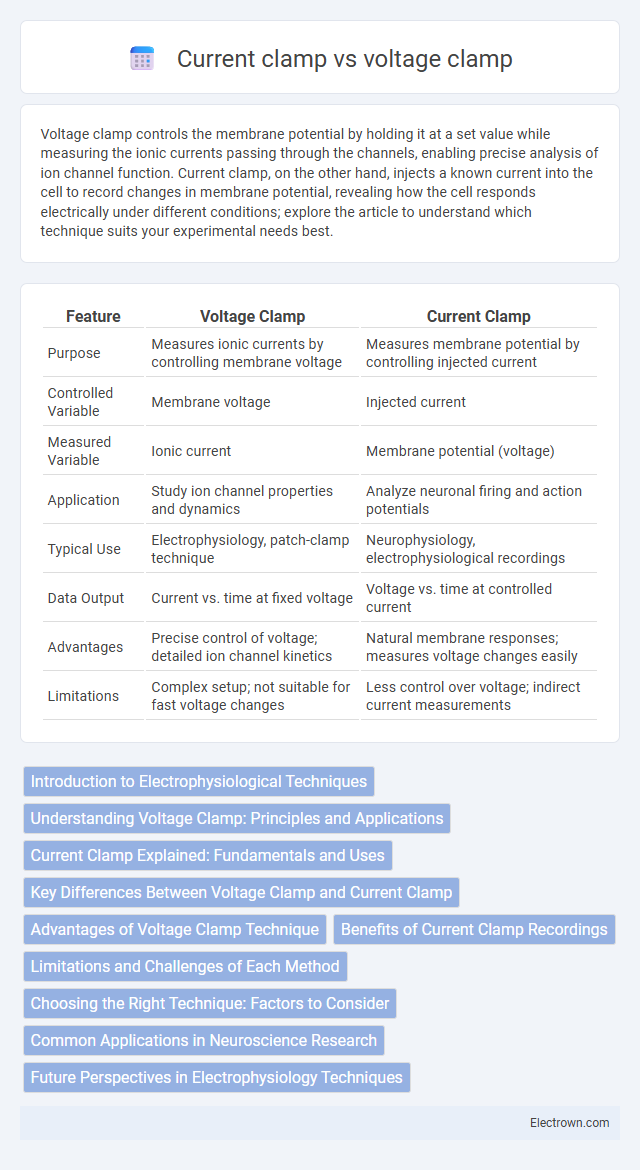Voltage clamp controls the membrane potential by holding it at a set value while measuring the ionic currents passing through the channels, enabling precise analysis of ion channel function. Current clamp, on the other hand, injects a known current into the cell to record changes in membrane potential, revealing how the cell responds electrically under different conditions; explore the article to understand which technique suits your experimental needs best.
Table of Comparison
| Feature | Voltage Clamp | Current Clamp |
|---|---|---|
| Purpose | Measures ionic currents by controlling membrane voltage | Measures membrane potential by controlling injected current |
| Controlled Variable | Membrane voltage | Injected current |
| Measured Variable | Ionic current | Membrane potential (voltage) |
| Application | Study ion channel properties and dynamics | Analyze neuronal firing and action potentials |
| Typical Use | Electrophysiology, patch-clamp technique | Neurophysiology, electrophysiological recordings |
| Data Output | Current vs. time at fixed voltage | Voltage vs. time at controlled current |
| Advantages | Precise control of voltage; detailed ion channel kinetics | Natural membrane responses; measures voltage changes easily |
| Limitations | Complex setup; not suitable for fast voltage changes | Less control over voltage; indirect current measurements |
Introduction to Electrophysiological Techniques
Voltage clamp and current clamp are fundamental electrophysiological techniques used to study ion channel behavior and membrane properties. Voltage clamp controls the membrane potential by fixing it at a set level to measure ionic currents, whereas current clamp records changes in membrane potential in response to injected current. These techniques provide essential insights into neuronal excitability and synaptic transmission, advancing your understanding of cellular electrical activity.
Understanding Voltage Clamp: Principles and Applications
Voltage clamp is a fundamental electrophysiological technique used to measure ionic currents across a neuron's membrane by holding the membrane potential at a set level. This method enables precise control of voltage to analyze ion channel behavior, such as conductance and kinetics. Applications of voltage clamp include studying action potential generation, synaptic transmission, and pharmacological effects on ion channels.
Current Clamp Explained: Fundamentals and Uses
Current clamp is a technique in electrophysiology that measures membrane potential while injecting a known current into the cell, allowing observation of voltage responses under controlled ionic conditions. This method is crucial for studying action potential firing, synaptic potentials, and ion channel function in neurons and muscle cells. Compared to voltage clamp, current clamp provides insights into the cell's natural electrical behavior by maintaining a constant current and recording dynamic changes in membrane voltage.
Key Differences Between Voltage Clamp and Current Clamp
Voltage clamp controls the membrane potential by fixing the voltage and measuring the resulting ionic currents, whereas current clamp injects a constant current to observe changes in membrane potential. Voltage clamp is essential for analyzing ion channel behavior under controlled voltage conditions, while current clamp reveals how neurons respond electrically to stimuli by tracking voltage changes. Your choice depends on whether you need to measure currents at set voltages or voltage changes due to controlled current inputs.
Advantages of Voltage Clamp Technique
The voltage clamp technique offers precise control over a cell's membrane potential, enabling accurate measurement of ionic currents without interference from changing voltage. This method allows detailed analysis of specific ion channel kinetics and conductance, providing critical insights into cellular electrophysiology. You benefit from reliable data that support the development of pharmacological treatments targeting ion channels.
Benefits of Current Clamp Recordings
Current clamp recordings provide precise measurements of membrane potential changes in response to controlled current injections, enabling detailed analysis of neuronal excitability and action potential generation. This technique allows you to observe dynamic patterns of voltage fluctuations under physiological conditions, facilitating the study of synaptic inputs and intrinsic cellular properties. Current clamp's ability to mimic natural electrical activity offers significant advantages for understanding complex neural signaling mechanisms.
Limitations and Challenges of Each Method
Voltage clamp techniques face limitations such as space clamp issues, restricting accurate control over large or complex neurons and causing voltage errors in extended dendrites. Current clamp methods struggle with difficulty in maintaining stable membrane potentials, especially during large or rapid ionic currents, leading to measurement inaccuracies. Your choice between these methods must consider these challenges to ensure precise electrophysiological data collection.
Choosing the Right Technique: Factors to Consider
Choosing between voltage clamp and current clamp techniques depends on the specific goals of your electrophysiological study. Voltage clamp is ideal for measuring ionic currents by holding the membrane potential constant, making it suitable for analyzing ion channel behavior and conductance. Current clamp is preferred when investigating changes in membrane potential and cellular excitability in response to current injections, providing insight into action potential generation and neuronal firing patterns.
Common Applications in Neuroscience Research
Voltage clamp techniques are commonly used in neuroscience to measure ionic currents through specific ion channels by holding the membrane potential constant, facilitating the study of ion channel kinetics and pharmacological effects. Current clamp methods allow researchers to record changes in membrane potential in response to injected currents, enabling the investigation of neuronal firing patterns and synaptic integration. Both techniques are essential for understanding neuronal excitability, electrophysiological properties, and signaling mechanisms in neural circuits.
Future Perspectives in Electrophysiology Techniques
Voltage clamp and current clamp techniques continuously evolve, enhancing precision in measuring ion channel dynamics and neuronal excitability. Future electrophysiology advancements integrate high-throughput screening, optogenetics, and real-time computational modeling to deepen understanding of cellular mechanisms. Miniaturized, automated patch-clamp systems and hybrid approaches promise improved spatial resolution and dynamic control of membrane potentials in complex neural networks.
Voltage clamp vs current clamp Infographic

 electrown.com
electrown.com